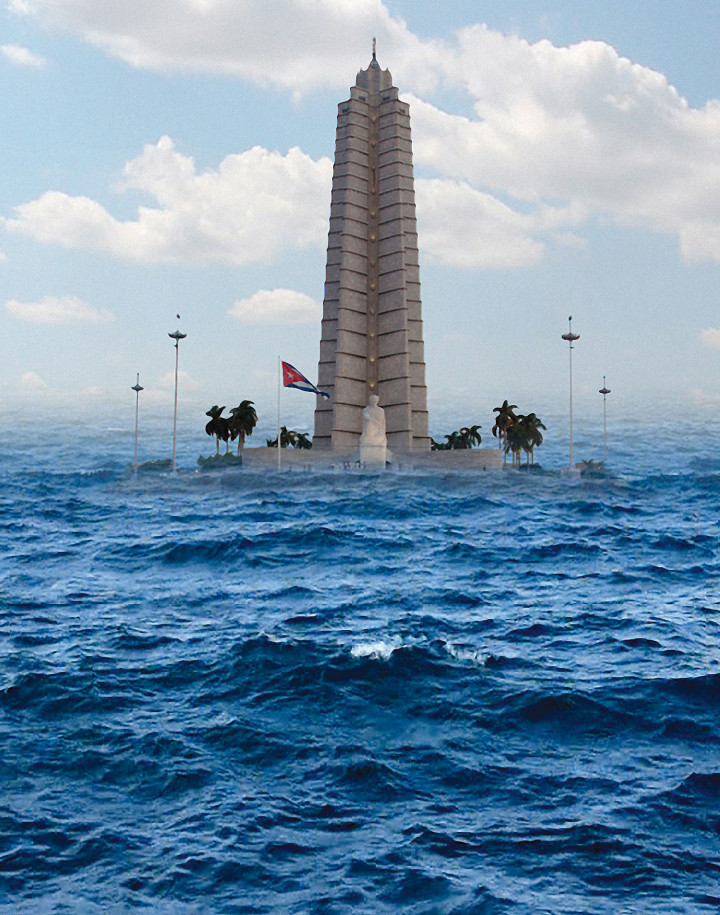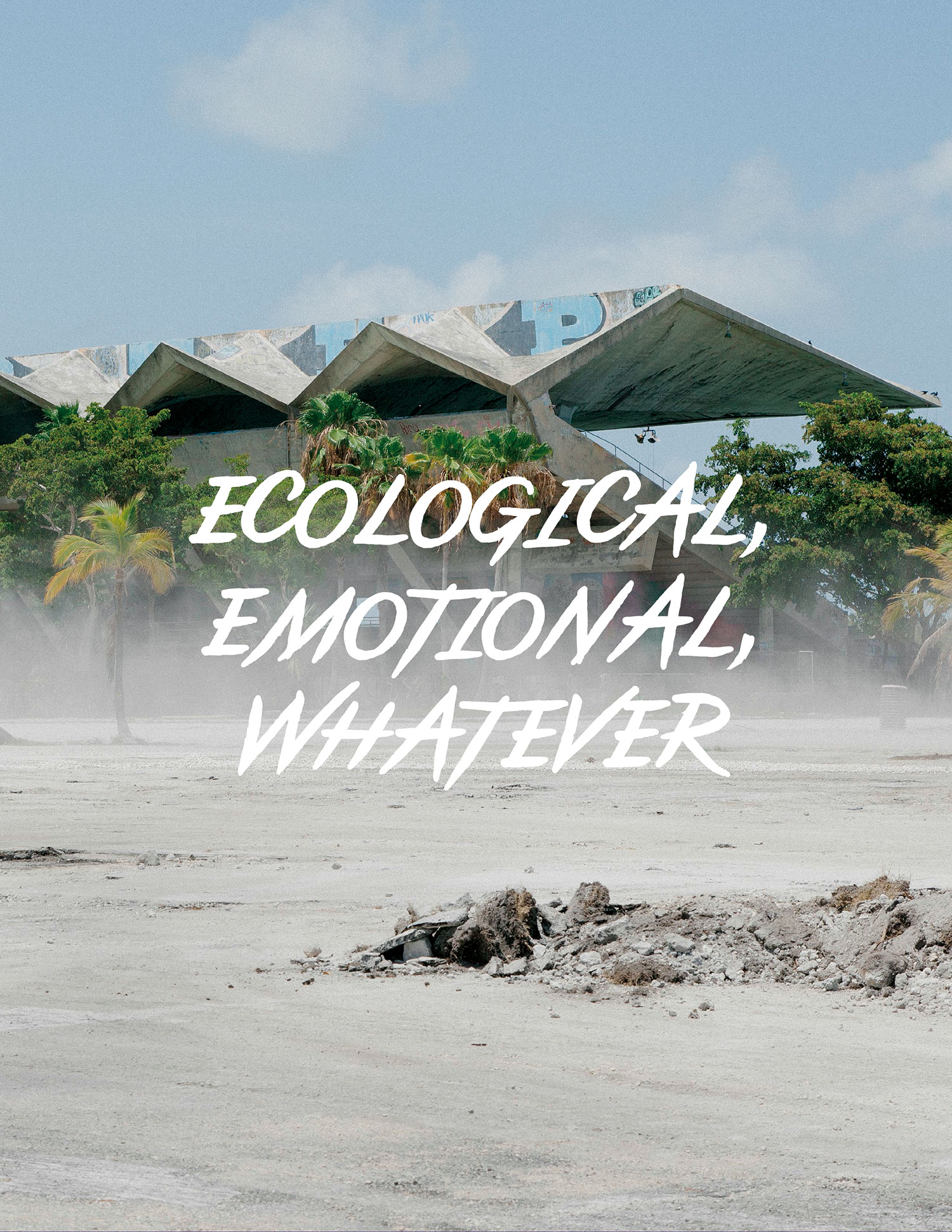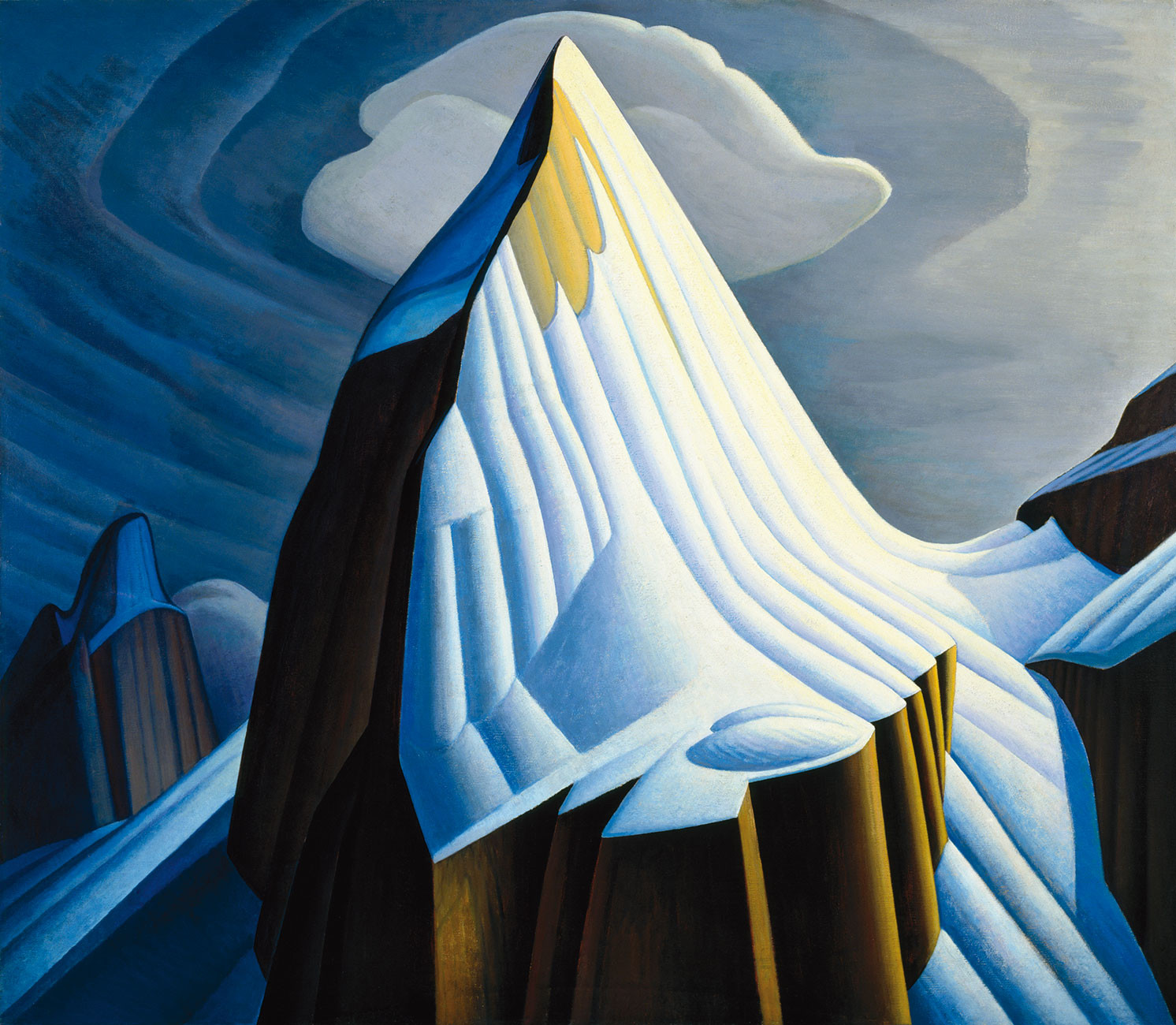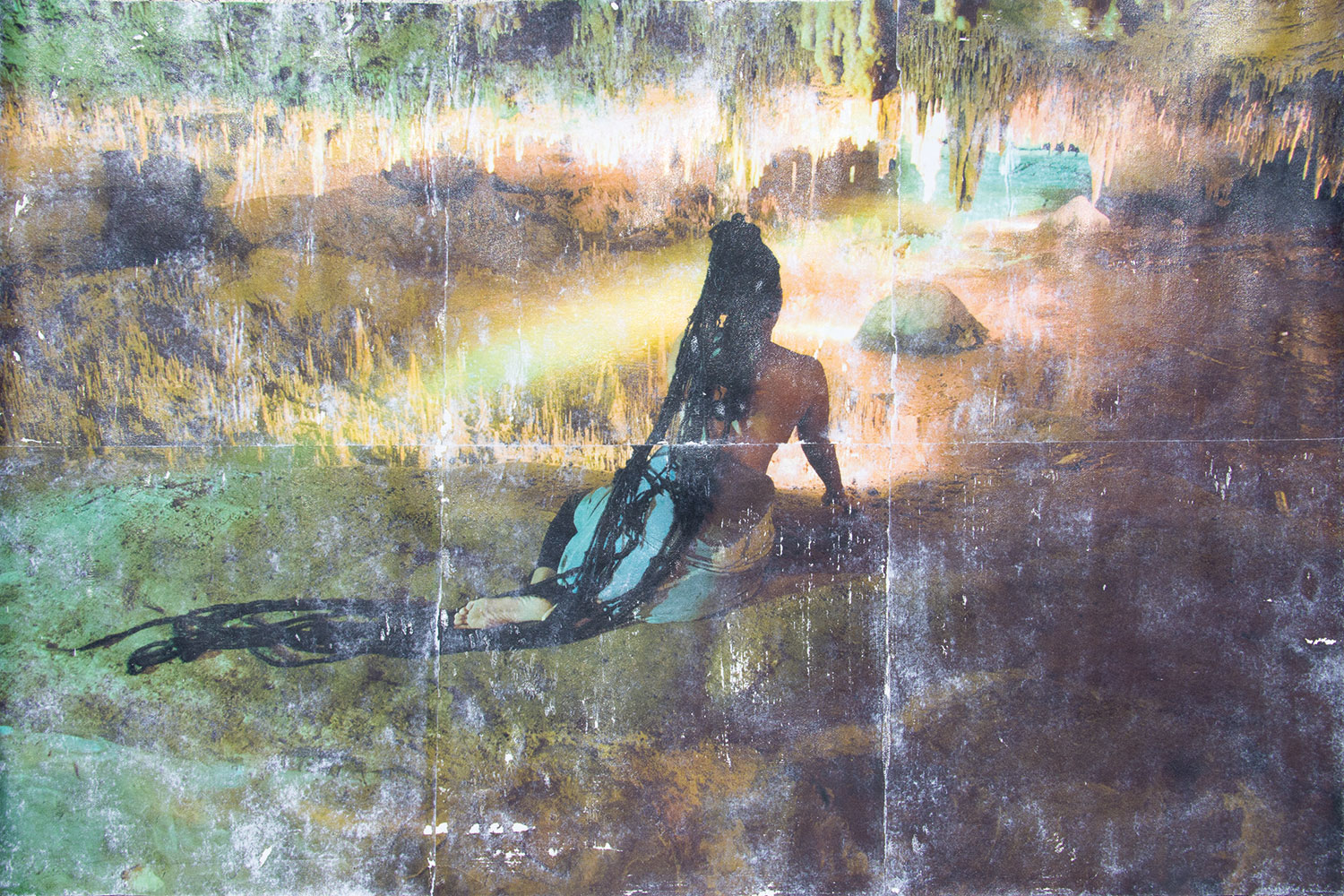
For the 2012 Havana Biennial, Roberto Fabelo Hung erected a translucent screen alongside Havana’s Malecón seawall, superimposing ghostly, digital reproductions of icebergs in a polar ocean onto the gauzy view of the sea behind it (Aire Fresco [Fresh Air], 2011). Through the semitransparent screen the real Caribbean ocean could be seen: contemporary Cuba as merged with the globe’s polar regions, or perhaps better, the former polar regions being eaten away by tropical waters in a period of frighteningly rapid climate change.
A half year later, Rafael Villares exhibited a “sound photograph” entitled La imagen que descansa (The Image at Rest, 2013). The viewer stares at a large photograph of a calm sea, while sounds of a storm recorded in the same spot play through headphones. The sense of a tempest lurking behind apparently tranquil waters opens up in the disjuncture between the visual and the aural. The dissonance is accentuated by the singular nature of the viewing experience, rather than the collective unease and action necessary to combat climate change. This tension between the singular and collective encounter with a changing nature is indicated by the work’s original title, since scrapped: Your Serenity Bothers Me. Shortly thereafter, in a series of watercolors exhibited in November 2013, painter Luis Enrique Camejo rendered images of Havana as if after an extreme flood, with cars and buildings half-submerged in surprisingly still waters.
The sea has long been a defining feature, indeed an inevitability, in Cuban art, literature, and life. Now it turns ominous. The placating distance of the Kantian sublime has telescoped. The ocean, that most given of givens on an island, has become an unknown entity at the heart of climate change. As environmental scientist James Hansen has underscored, “the most important climate feedbacks all involve water, in either its solid, liquid, or gas form.” [Storms of My Grandchildren: The Truth About the Coming Climate Catastrophe and Our Last Chance to Save Humanity, Bloomsbury, New York, 2009, p. 42] Only two decades after Chile transported an iceberg to the Universal Exposition in Seville (1992), a gesture that art critic Nelly Richard critiqued for its patent aspirations towards whiteness (versus indigeneity), purity (versus the recent, dirty past of the Pinochet dictatorship), and a neoliberal sheen that seemed to recapitulate the globalism of the year 1492 celebrated at the Exposition, Fabelo Hung’s icebergs in 2012 suggest quite other referents. [“The Graphic Model of an Advertising Identity,” in Cultural Residues: Chile in Transition, University of Minnesota Press, Minneapolis, 2004, pp. 116–17]
Aire Fresco exceeds the simple pleasures afforded by art’s ability to summon the impossible (icebergs in the Caribbean) since the floating chunks of ice seem increasingly implausible anywhere, reminding us of the rapid disintegration of polar caps in warming oceans. Whiteness is here less a symbol of naturalized hierarchies than a secretly essential color for the survival of the planet. For, as it happens, one of the most basic elements of art — color, or its absence — turns out also to be a basic element determining the science of our endangered future. A warming earth melts ice and snow, both of which possess reflectivity, or “albedo” (whiteness), allowing them to reflect “back to space most of the sunlight that hits them. Land and ocean, on the other hand, are dark, absorbing most of the sunlight that strikes them. If ice and snow melt, Earth absorbs more sunlight, which is a ‘positive’ (amplifying) feedback.” [Storms of My Grandchildren, p. 42.] Vanishing whiteness from the polar caps means warmer waters, which, as they melt ice shelves, release currents of water that sunder still more ice. Scientists have predicted “ice-free” summers in the Arctic by 2018, or even as early as 2016.

These changes, catastrophic as they will surely be for nonhuman “nature,” will reconfigure human life too. Hansen speculates that “global chaos” will be difficult to avoid as ice melt continues, and wonders where people from low-lying areas such as Bangladesh will move on to, as their lands disappear. But Bangladesh at least enjoys the relative advantage of contiguous land. Cuba, on the other hand, is part of the Association of Small Island States (AOSIS), a group of some fifty small islands rapidly imperiled by climate change. As a recent study suggests, “climate departure” — the moment when temperatures in a given region will always be warmer, the coldest years hotter than the hottest years during the mid-to-late twentieth century — is likely to hit the Caribbean as early as 2023 (and the rest of the planet by 2047). Some reports are predicting a global climate that will be several degrees warmer as soon as the next two years.
In light of such news, another work exhibited in the 2012 biennial, Liudmila & Nelson’s Absolute Revolución: La isla (Absolute Revolution: The Island, 2003–09), takes on a different cast. Absolute Revolution is a video that transposes the Martí monument from Havana’s Plaza de la Revolución onto a background of waves, as if the obelisk were an Atlantis emerging from, or descending into, the open sea. Complementing the two artists’ vision of islands disappearing into the ocean is author Nuria Ordas’s science-fiction novella Entremundos (Betweenworlds, 2010), which imagines a Caribbean future under ozoneless skies:
Many cities had been lost forever. Of the small islands, once dispersed throughout the oceans, not half remained, and in those that did it became almost impossible to live, because the tsunamis, floods and storms made them uninhabitable. The sun had grown lethal; it caused serious and painful burns. The long-frozen icecaps had, moreover, melted in only a few years. Many territories took precautions. Building the Frontón [a stronger version of Havana’s seaside Malecón wall] was one of them. [Entremundos, Editorial Gente Nueva, Havana, 2010, p. 15.]
Of course, the omnipresence of water in Cuba’s cultural imagination is nothing new. The best-known Cuban poem of the twentieth century, Virgilio Piñera’s 1943 La isla en peso (The Whole Island), famously begins: “The curse of being completely surrounded by water / condemns me to this café table.” The obsession with the sea and with insularity persists in Cuban art.
Contemporary art has been less concerned with local challenges and more preoccupied with urgent and spectacular problems, both far-flung and regional. Humberto Díaz, for instance, who works in multiple media, made the striking piece Tsunami (2009), a giant sculpture built of terracotta roof tiles that appear at once Japanese and Mediterranean. The tiles heave and dip, emulating giant waves, after Katsushika Hokusai’s famous print The Great Wave Off Kanugawa (c. 1830). The rippled and uneven tiles also suggest the debris of roofs carried away by a tsunami, like the devastating wave that hit Indonesia in 2008, or anticipating the disaster of Fukushima in 2012. Díaz has said that he sought to render in art the “cause-effect” relation between humans and the environment, in order to suggest an “apocalyptic” vision of the world resulting from industry’s effects on the environment.
Tsunami’s variegated and undulating surface is created by the structures supporting the waves: cardboard boxes and shapes of varying heights, designed to reproduce the miniature gullies and rises within the larger wave. The imperfect composition of terracotta roof tiles suggests an artisanal craftiness, rather than a computer-generated simulation. It also suggests that the tiles are like the epiphenomenon of the underlying structures, invisible to the human eye except in their effects: rising temperatures, rising sea levels. The overlapping or disjunctive tiles figure overwhelming, imminent or arrived change like a wave crashing unevenly over us. Human-wrought “sea change” takes on local, specific versions: the piece was assembled differently in Havana and Saint Petersburg, for instance. In a nice, although probably accidental symmetry, scholars believe that the wave Hokusai rendered was not actually a tsunami but an “extreme wave” built of many small crests of waves, like Díaz’s own piece.
This apocalyptic vision has been echoed in the work of the more blithely commercial painter Camejo, whose series of watercolors “La isla del día después” (The Island the Day After) was exhibited in December 2013. While Cuban kitsch, done right, once signaled an embrace of popular culture and rejection of grand narratives, a tourist-oriented version has become one option available for artists forced to turn to markets, minor and elite. (Other options include the kind of “global contemporary” aesthetic of which Díaz is perhaps an example, overtly “political” art, and a recent boom in painting.)
Camejo’s work, with its images of old cars and vistas of the city’s waterfront, flirts unironically with the aesthetic of the kind of paintings sold in tourist souvenir shops or outdoor fairs. But it also appeals to many Cubans interested in a legible and cinematic painting. Camejo is best known for dichromatic oil paintings of cosmopolitan cities (Havana, Panama City, Amsterdam), where he lingers on surfaces and reflections: bus windows, shop vitrines, revolving doors, railroad tracks, rainy sidewalks. In La isla del día después #4 he widens these reflective surfaces into an ever-present watery medium swallowing up the city.

La isla del día después #4 offers a view into the heart of the city, looking upwards from Havana’s majestic Prado pedestrian walk. The foreground is flooded by what must be a swollen sea and torrential rain. Yet the scene is serene, not particularly disaster-stricken: reflections on the water’s surface from the buildings and streetlight poles are smooth and unbroken by any current or wind. Indeed, the scaffolding around a building in ruins — a faithful rendering of a currently existing structure — suggests the precariousness of current infrastructure before any natural disaster has struck. Rather than constituting evidence of a churning force of nature, the pooled water seems only one more stultifying element in a rather uneventful Caribbean capital. Still, no people are visible: only an empty car suggests human traffic. The image suggests the sinking of the city into a watery future.
The most interesting detail of La isla del día después #4 is the spectator’s implied position, either in the ocean or just beside it at the Malecón (which would presumably be submerged as well). Yet even this curious positioning seems less the painting’s point than a casualty of the need to render the cinematic image that Camejo wants to push: the city’s most beautiful promenade; the distant, august Capitol in the background; a colonial building opening onto the ornate warren of streets of Centro Habana; the requisite old car. The vantage is thus less about an uncanny positioning or even a sublime contemplation of nature’s power than it is a filmic gaze upon post-crisis cities as we have seen them before, in countless movies (which the painting series’ title also invokes), reminding us that “apocalypse” originally meant a visual revelation.
Harold Vázquez Ley focuses on the changes suffered by photography, a medium whose documentary quality supplants any need for a real referent. Digital images are consumed and multiplied on a scale not previously possible. In the series “Límites de salinación” (Salination’s Limits, 2010) he has thus staged geographies that do not exist, in photographs that are not photographs: Nordic landscapes of snowy pine trees; textured, aging colonial stones; hand-pixilated, newspaper-like images of baseball plays, all made of salt crystals on a black background. The collection of salt “photographs” entitled “Entropomorfía” (Entropomorphy, 2010) further explores the resonance between photography’s questionable indexicality and its newly dubious fidelity to a world in which familiar landscape scenes no longer exist.
Photography has always captured temporal “nows” that have passed. It has often staged worlds that do not exist. Vázquez Ley’s salt “photographs,” however, do something different. They present a real world that no longer exists.
“Entropomorfía” is based on older photographs that still circulate on the internet, of glaciers that have melted away. Again Vázquez Ley creates the images by arranging salt crystals. He works with salt because it approximates pixels, and because its properties connect it to entropy’s principle of equilibrium. Here, however, the equilibrium he wishes to invoke is not that of some organic process of elements balancing each other out. Rather, he is interested in the balance between information and disinformation, reality and irreality, that is created by the “relative death” enabled by the persistence of aging images on the internet.
“Entropomorfía” is important because it suggests one of the ways that aesthetics can — quite uniquely — help us comprehend a changing relation to both the material world and its digital renderings. Ecological aesthetics need not merely provide content about environmental crisis. Form and aesthetics themselves have something to teach us about our relation to “the outside world,” to the “ecology without nature” that Timothy Morton has called for. Vázquez Ley suggests that how we think about history and the present, material reality and images, and information and disinformation, informs how we interact with “ecology” and how we construe nature as one element of another antagonistic pair, against culture.
Before examining “Entropomorfía” more closely, I want to turn to some recent theories from literary studies that help us grasp the import of Vazquez Ley’s series. Recently, the critic Jacques Khalip has attempted to grapple with how poetry can help us think about environmental crisis. His work in part responds to the implicit question of why one should even worry about poetics or art when faced with species-wide extinctions, including our own. Khalip proposes that the very concepts that seem most concrete and irrefutable, most beyond language and aesthetics — concepts such as extinction — can be productively opened up through art. He finds, for instance, that the seemingly catastrophic charge of extinction still harbors within it a secret hope for redemption. The idea of extinction thus exists in part, Khalip argues, to warn us about how we may yet avert it.

But what would happen if extinction were a concept that resisted being marshaled for intervention into crisis? Can we consider ideas about time, nature and change that would be beyond humanism altogether? In an era of radical breaks such as climate “departure” — which, according to contemporary science at least, is irreversible — we need, Khalip writes somewhat perversely, to “stop thinking of extinction itself as answerable to a before/after logic — to question how we distribute, apportion and designate what counts as brimming with ‘life.’” [“Now No More,” n.p.] Our most basic notions of life themselves are tied to a romantic humanism. Aesthetics that reflect on the anthropocene ought not reinstall humans at their center, Khalip argues, even if we have created the current geological epoch. Hard as it is to conceive of, our concepts of change and time must address the nonhuman environment.
Vázquez Ley’s saline images of the eroded glaciers Quilka, Cook and Del Ruiz assume a related stance about what extinction might mean today. They offer a commentary on how representation and “ecology” (or “nature”) today both increasingly refer to missing referents. The series is concerned with vanishing or death, both informational and material. It makes human and nonhuman death in some ways equivalent. This is a singular insight: while photography has perhaps more than with any other medium been associated with subjectivity and human death, its affinity with other kinds of disappearances has typically received less attention. Vázquez Ley translates natural extinction of both species and their habitats into the vocabulary of photography. He uses aesthetics to process climatological events.
Subhankar Banerjee, one of the preeminent photographers of climate change today, has pointed out that while we have vast archives of human portrait photography, there have been virtually no exhibitions of portraits of animals. [“Ought We Not to Establish ‘Access to Food’ as a Species Right?,” Third Text 27, no. 1 (2013), pp. 33–43.] Vanishing landscapes have fared better, but even they have not pressed photography’s urgent relation to death to the degree that human portraiture has.
Vázquez Ley uses photography’s intimate relation to death to tie referential loss in the natural world to replication in the digital. In his work, photography not only registers something that is no longer with us, but registers the fact that absence itself produces immaterial excess. The loss of the real glacier spurs the circulation of digital records of its former state.
In the nineteenth century the deathbed photograph was meant to counteract a person’s slipping away. Today the loss of species, places and ways of life produces a retrospective archive of the recently departed. For Vázquez Ley, the temporality according to which things and beings are used up and pass into extinction extends from the rapid, artificially cycling of industrial fashion into glacial time. The production of the former may even occasion the demise of the latter.
Manuel Castells borrowed the term “glacial time” from Scott Lash and John Urry to describe an enduring time that links humans and nature, and stretches several generations into the future (the relation between a person and her great-grandchildren, for instance). Castells placed glacial time in distinction to clock time (that of the state, industrialism) and “atemporal time” (that of the information society, of “instant wars” and financial transactions). [“El reverdecimiento,” p. 23] Now the term seems poignantly dated to a recent past of less spectacular global warming, in which “glacial” connoted permanence beyond observable change.





